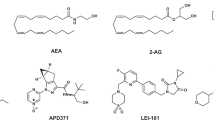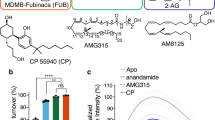Abstract
Interest in cannabinoid pharmacology increased dramatically upon the identification of the first cannabinoid receptor (CB1) in 1998 and continues to expand as additional endocannabinoids and cannabinoid receptors are discovered. Using CB1 receptor (CB1R) systems, medicinal chemistry programs began screening libraries searching for cannabinoid ligands, ultimately leading to the discovery of the first potent cannabinoid receptor antagonist, SR141716A (Rimonabant). Its demonstrated efficacy in treating obesity and facilitating smoking cessation, among other impressive pharmacological activities, has furthered the interest in cannabinoid receptor antagonists as therapeutics, such that the number of patents and publications covering this class of compounds continues to grow at an impressive rate. At this time, medicinal chemistry approaches including combinatorial chemistry, conformational constraint, and scaffold hopping are continuing to generate a large number of cannabinoid antagonists. These molecules provide an opportunity to gain insight into the 3-dimensional structure-activity relationships that appear crucial for CB1R-ligand interaction. In particular, studies in which conformational constraints have been imposed on the various pyrazole ring substituents of SR141716A provide a direct opportunity to characterize changes in conformation/conformational freedom within a single class of compounds. While relatively few conformationally constrained molecules have been synthesized to date, the structure-activity information is often more readily interpreted than in studies where entire substituents are replaced. Thus, it is the focus of this mini-review to examine the structural properties of SR141716A, and to use conformationally constrained molecules to illustrate the importance of conformation and conformational freedom to CB1R affinity, selectivity, and efficacy.
Similar content being viewed by others
References
Cleland JG, Ghosh J, Freemantle N, et al. Clinical trials update and cumulative meta-analyses from the American College of Cardiology: WATCH, SCD-HeFT, DINAMIT, CASINO, INSPIRE, STRATUS-US, RIO-Lipids and cardiac resynchronisation therapy in heart failure. Eur J Heart Fail. 2004;6:501–508.
Muccioli GG, Lambert DM. Current knowledge on the antagonists and inverse agonists of cannabinoid receptors. Curr Med Chem. 2005;12:1361–1394.
Padgett LW. Recent developments in cannabinoid ligands. Life Sci. 2005;77:1767–1798.
Lange JH, Kruse CG. Keynote review: medicinal chemistry strategies to CB1 cannabinoid receptor antagonists. Drug Discov Today. 2005;10:693–702.
Hurst DP, Lynch DL, Barnett-Norris J, et al. N-(piperidin-1-yl)-5-(4-chlorophenyl)-1-(2,4-dichlorophenyl)-4-methyl-1H-pyrazole-3-carboxamide (SR141716A) interaction with LYS 3.28(192) is crucial for its inverse agonism at the cannabinoid CB1 receptor. Mol Pharmacol. 2002;62:1274–1287.
Francisco ME, Seltzman HH, Gilliam AF, et al. Synthesis and structure-activity relationships of amide and hydrazide analogues of the cannabinoid CB(1) receptor antagonist N-(piperidinyl)-5-(4-chlorophenyl)-1-(2,4-dichlorophenyl)-4-methyl-1H-pyrazole-3-carboxamide (SR141716). J Med Chem. 2002;45:2708–2719.
Carpino PA, Griffith DA, Sakya S, et al. New bicyclic cannabinoid receptor-1 (CB(1)-R) antagonists. Bioorg Med Chem Lett. 2006;16:731–736.
Rinaldi-Carmona M, Barth F, Millan J, et al. SR 144528, the first potent and selective antagonist of the CB2 cannabinoid receptor. J Pharmacol Exp Ther. 1998;284:644–650.
Wiley JL, Jefferson RG, Grier MC, Mahadevan A, Razdan RK, Martin BR. Novel pyrazole cannabinoids: insights into CB(1) receptor recognition and activation. J Pharmacol Exp Ther. 2001;296:1013–1022.
Thomas BF, Francisco ME, Seltzman HH, et al. Synthesis of longchain amide analogs of the cannabinoid CB1 receptor antagonist N-(piperidinyl)-5-(4-chlorophenyl)-1-(2,4-dichlorophenyl)-4-methyl-1H-pyra zole-3-carboxamide (SR 141716) with unique binding selectivities and pharmacological activities. Bioorg Med Chem. 2005;13:5463–5474.
Mussinu JM, Ruiu S, Mule AC, et al. Tricyclic pyrazoles. 1. Synthesis and biological evaluation of novel 1,4-dihydroindeno[1,2-c]pyrazol-based ligands for CB1 and CB2 cannabinoid receptors. Bioorg Med Chem. 2003;11:251–263.
Bass CE, Griffin G, Grier M, Mahadevan A, Razdan RK, Martin BR. SR-141716A-induced stimulation of locomotor activity: a structure-activity relationship study. Pharmacol Biochem Behav. 2002;74:31–40.
Stoit AR, Lange JH, Hartog AP, et al. Design, synthesis and biological activity of rigid cannabinoid CB1 receptor antagonists. Chem Pharm Bull (Tokyo). 2002;50:1109–1113.
Murineddu G, Ruiu S, Loriga G, et al. Tricyclic pyrazoles. 3. Synthesis, biological evaluation, and molecular modeling of analogues of the cannabinoid antagonist 8-chloro-1-(2′, 4′-dichlorophenyl)-N-piperidin-1-yl-1,4,5,6-tetrahydrobenzo[6,7]cyclohepta[1,2-c]pyrazole-3-carboxamide. J Med Chem. 2005;48:7351–7362.
Murineddu G, Ruiu S, Mussinu JM, et al. Tricyclic pyrazoles. 2. Synthesis and biological evaluation of novel 4,5-dihydro-1H-benzo[g]indazole-based ligands for cannabinoid receptors. Bioorg Med Chem. 2005;13:3309–3320.
Author information
Authors and Affiliations
Corresponding author
Additional information
Published: October 27, 2006
Rights and permissions
About this article
Cite this article
Thomas, B.F., Zhang, Y., Brackeen, M. et al. Conformational characteristics of the interaction of SR141716A with the CB1 cannabinoid receptor as determined through the use of conformationally constrained analogs. AAPS J 8, 76 (2006). https://doi.org/10.1208/aapsj080476
Received:
Accepted:
DOI: https://doi.org/10.1208/aapsj080476




